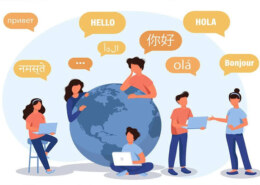Language is a structured system of communication used by humans, characterized by a set of sounds, symbols, gestures, or rules that convey meaning within a community. It’s a dynamic and versatile tool for expressing thoughts, ideas, emotions, and sharing information.
Key characteristics of language include:
Structure: Languages have grammar, syntax, and rules that govern how words and phrases are combined to form meaningful expressions. This structure allows for effective communication and comprehension.
Diversity: There are thousands of languages worldwide, each with its unique vocabulary, grammar, and phonetics. Languages vary significantly across cultures and regions.
Modes of Expression: Language can be spoken, written, or conveyed through non-verbal forms such as sign language or body language. It allows for diverse ways of communication.
Social Function: Language serves as a tool for social interaction, facilitating connections and relationships among individuals and communities. It enables sharing stories, passing on traditions, and transmitting knowledge.
Development and Adaptation: Languages evolve over time due to cultural changes, interactions between different communities, and technological advancements. They adapt to meet the needs of their speakers and incorporate new words and concepts.
Universal and Specific Elements:
While languages share common features, each language also has unique characteristics and nuances that reflect the culture and history of its speakers.
Language is an integral part of human life, serving as a medium for expressing thoughts, shaping identities, and connecting people across diverse backgrounds and experiences. Language plays a significant role in shaping personal and group identity. It’s a key aspect of culture, influencing how individuals perceive themselves and how others perceive them within social contexts. These roles includes:
Personal Identity:
Language use often reflects a person’s background, upbringing, and heritage. One’s native language can be a strong identifier of individual identity, as it connects them to their roots and cultural heritage.
Code-switching, the practice of alternating between two or more languages or dialects in conversation, is common among bilingual individuals. It enables them to express various aspects of their identity and adapt to different social situations. For instance, someone might use one language with family and another at work or in academic settings.
Group Identity:
Shared language within a community or group fosters a sense of belonging and solidarity. It can create a bond among individuals who share the same language and cultural practices.
Language attitudes towards different dialects or languages also impact group identity. Societal perceptions about certain languages or dialects can influence how speakers of those languages view themselves and others. For instance, prestige languages often carry more social status and influence than others within a society.
Code-switching:
It allows individuals to navigate diverse social environments. Switching between languages can signify inclusivity, intimacy, or assert cultural identity in specific contexts.
Some view code-switching positively as a skill that enhances communication, while others might see it as a sign of insufficient proficiency in either language.
Language Attitude:
Language attitudes are individuals’ feelings and beliefs about different languages or dialects. These attitudes can range from positive to negative and can affect how people perceive their own language and the languages spoken by others.
Societal attitudes towards certain languages can lead to language discrimination or the devaluation of specific linguistic varieties, impacting the identity and self-esteem of speakers.
In essence, language is not just a means of communication but also a powerful tool that shapes personal and group identity, influences social interactions, and reflects cultural belonging. The interplay between language and identity involves a complex relationship influenced by historical, societal, and individual factors.

